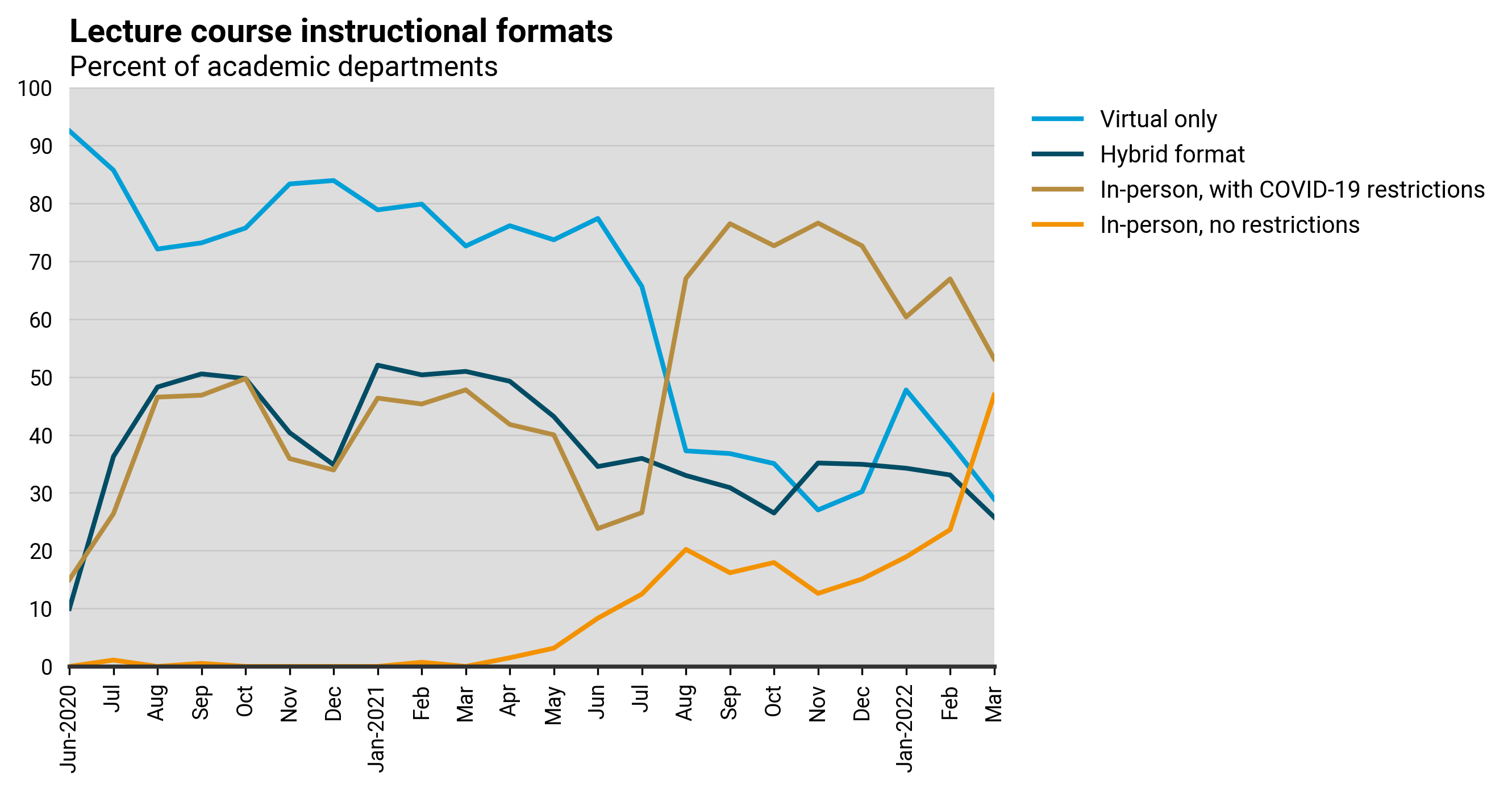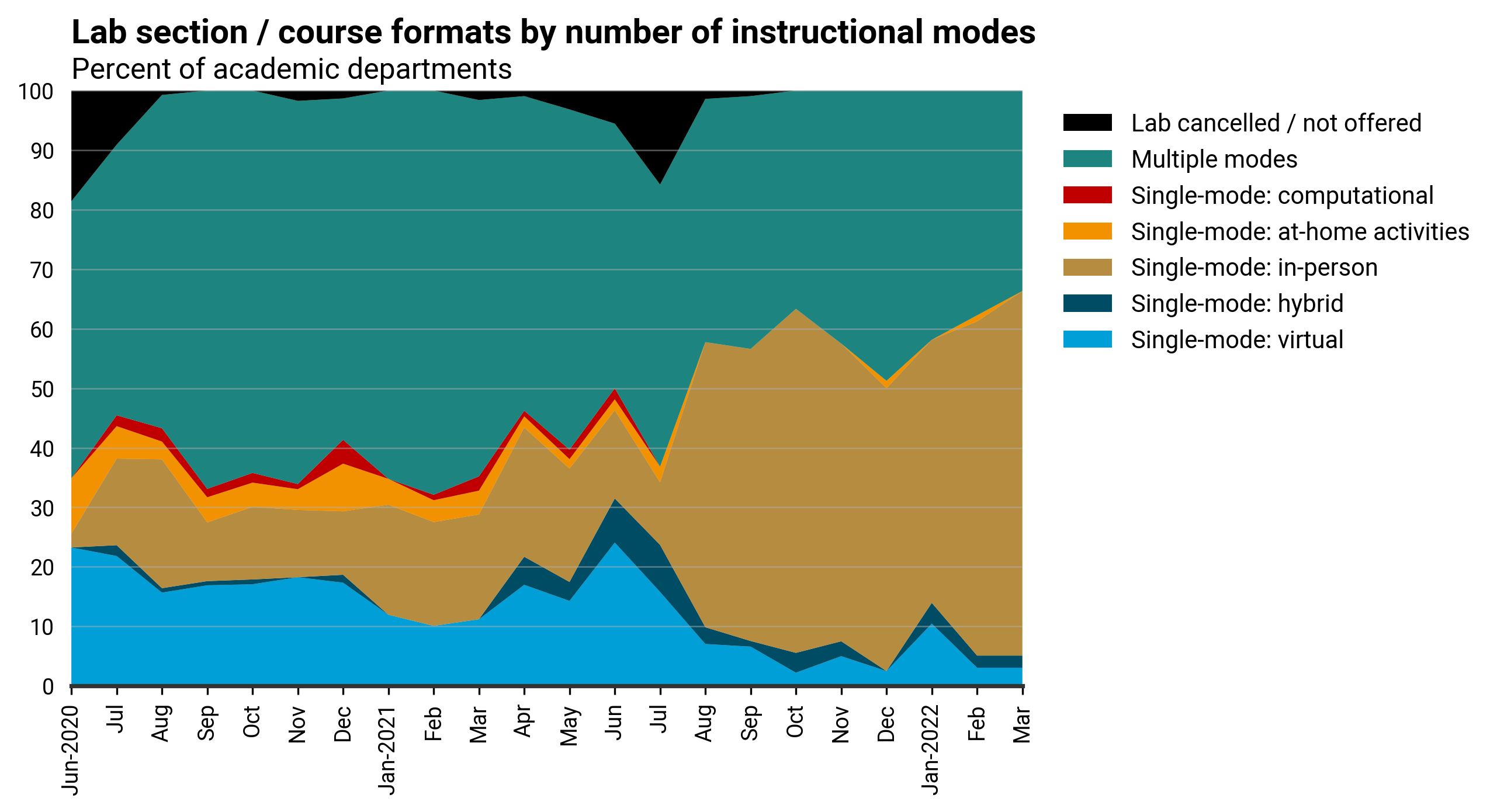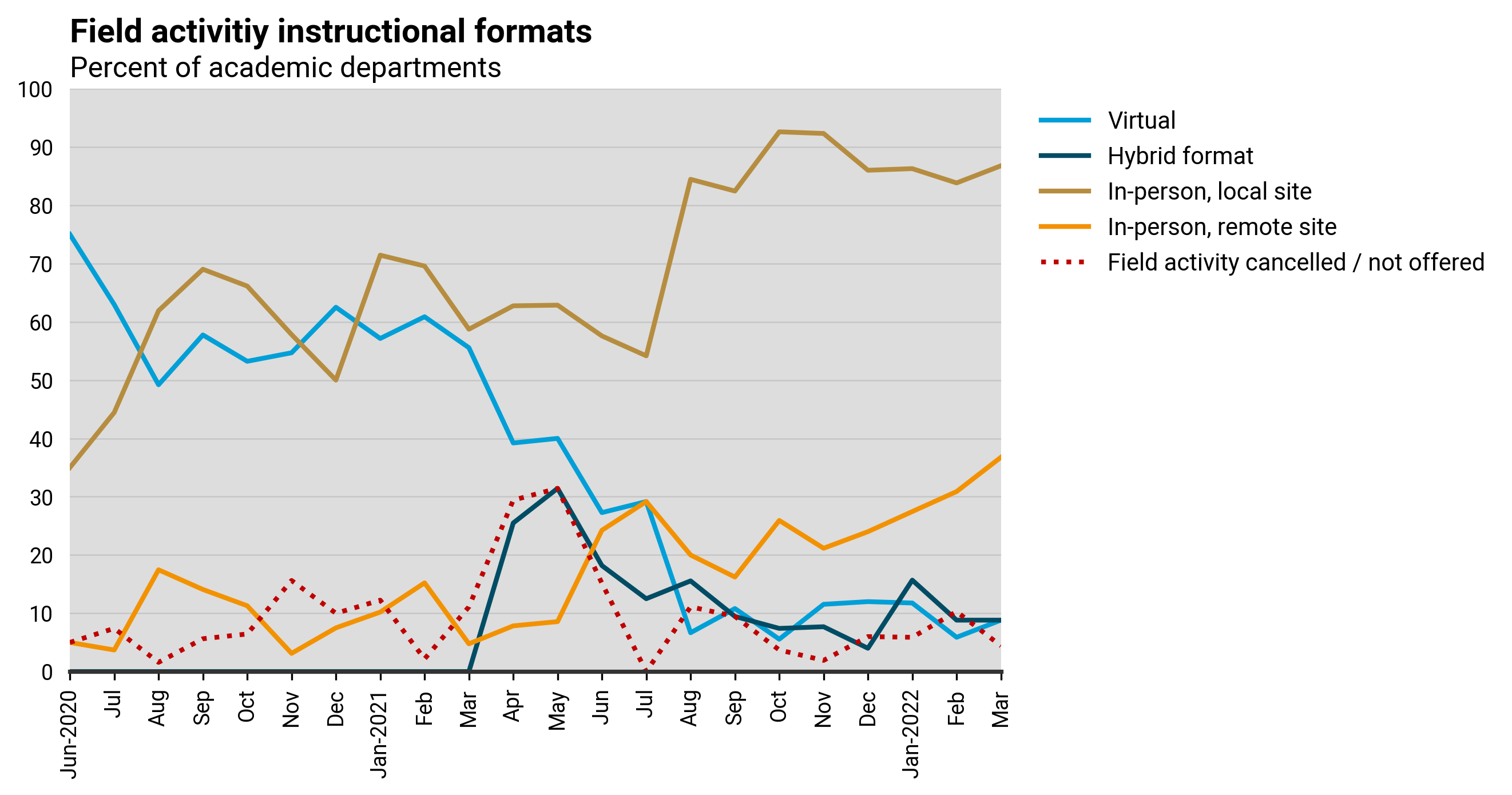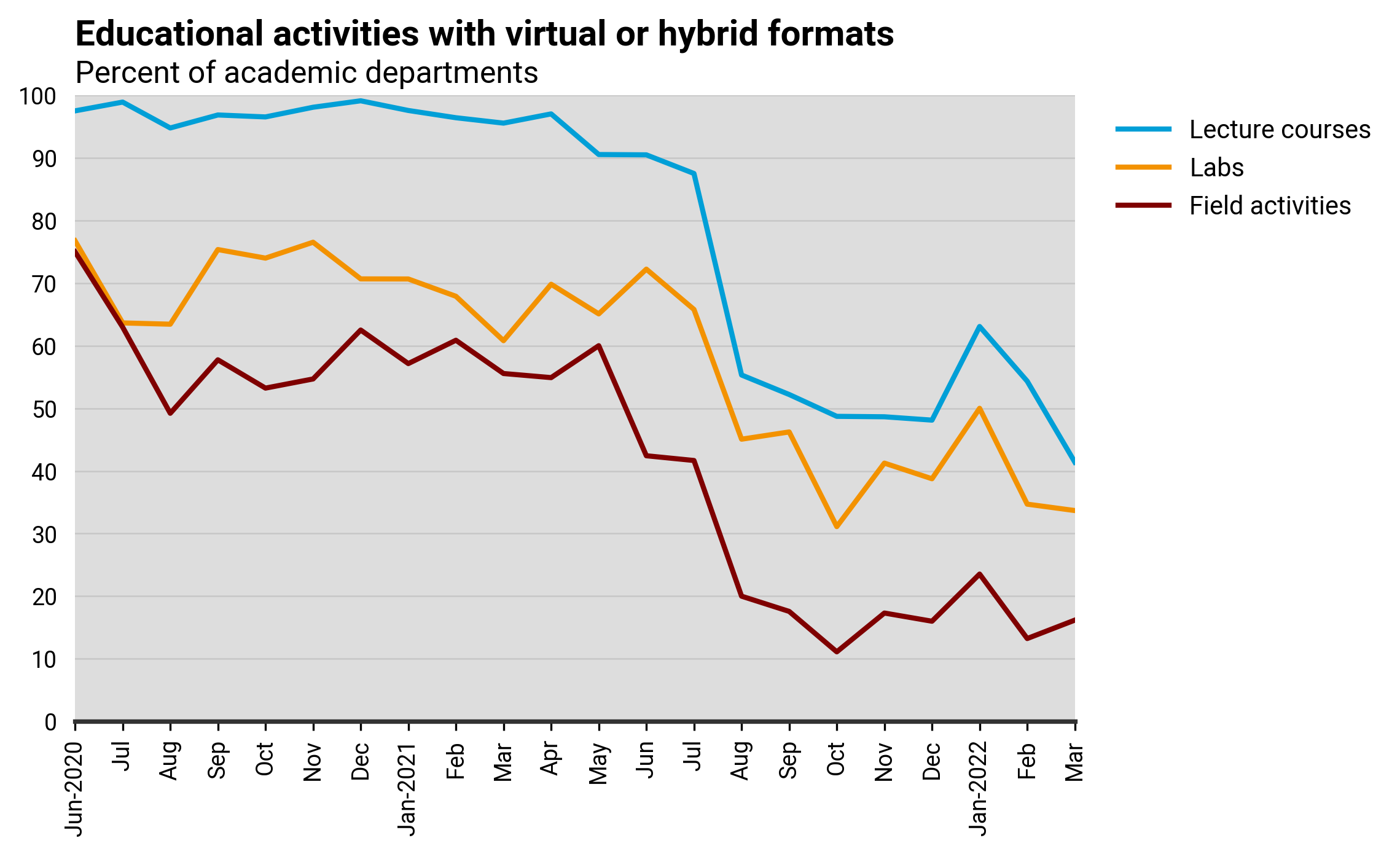Data Brief 2022-004 | May 6, 2022 | Written and compiled by Leila Gonzales and Christopher Keane, AGI
Download Data Brief
Pandemic Impacts to Instructional Formats through March 2022
Lecture course instructional modes
During the pandemic, courses, labs, and field activities have rapidly
shifted between online, in-person and hybrid modes of instruction in
response to pandemic conditions. With mask mandates easing in early 2022
as the impacts of the Omicron surge waned, there was a return to
predominantly in-person instruction for lecture courses, labs, and field
activities.
By the start of the Fall 2021 term, most geoscience academic departments
resumed in-person instruction with pandemic-related restrictions in
place. However, with the spread of the Omicron variant in early 2022,
instructional modes transitioned to the use of more virtual instruction.
By March 2022, over half of departments reported resumption of only
in-person instruction for lecture courses. The return to in-person
instruction with no pandemic-related restrictions increased in late
2021.
Part of the strain associated with teaching during the pandemic has been
the need for faculty to teach via multiple instructional modes. In
addition, faculty have consistently reported that the workload
associated with course preparation and delivery for virtual and hybrid
formats has been much higher than in-person instruction. By March 2022,
two-thirds of departments reported that lecture courses were being
taught using a single mode of instruction (i.e., only virtual
instruction, only hybrid instruction, or only in-person instruction),
and one-third of departments reported that lecture courses were
delivered in multiple modes of instruction, usually a combination of
in-person instruction with hybrid and/or virtual only formats.

DB_2022-004 chart 01: Lecture course instructional formats (Credit: AGI; data from AGI's Geoscience COVID-19 Survey)
AGI

DB_2022-004 chart 02: Lecture course formats by number of instructional modes (Credit: AGI; data from AGI's Geoscience COVID-19 Survey)
AGI
Lab section / course instructional modes
Instructional modes for lab sections have followed a similar trajectory
to lecture courses. While in 2020, most departments reported using
virtual labs, that percentage declined through 2021 concurrent with the
decline in the use of at-home and computational lab activities. By the
start of the Fall 2021 term, most departments had returned to in-person
lab instruction, with half of departments reporting that they only
offered in-person lab instruction and approximately one-fifth of
departments offering dual modes of instruction (i.e., in-person and
hybrid or virtual formats). During the Omicron surge in early 2022,
there was an uptick in the use of virtual labs, and with the roll-back
of mask mandates, a rapid increase in the percentage of departments
reporting a return to in-person instruction without pandemic-related
restrictions.
Throughout the pandemic, lab sections and courses have predominantly
been offered in multiple formats, with some combination of virtual,
hybrid, and in-person, often with at-home and/or computational
activities supplementing or replacing in-person lab activities. With the
start of the Fall 2021 term, the percentage of departments offering only
one mode of instruction increased as in-person labs resumed, and by
March 2022, over 60% of departments offered only in-person lab sections
and courses.

DB_2022-004 chart 03: Lab section / course instructional formats (Credit: AGI; data from AGI's Geoscience COVID-19 Survey)
AGI

DB_2022-004 chart 04: Lab section / course formats by number of instructional modes (Credit: AGI; data from AGI's Geoscience COVID-19 Survey)
AGI
Field activity instructional modes
In Fall 2021, field instruction returned to in-person instruction, but
primarily at local sites with over half of departments offering only
in-person field instruction. Limitations on vehicle usage and travel
persisted for many departments, which likely was a factor limiting the
geographic range of field activities. By March 2022, the use of virtual
and hybrid field activities had diminished while over one-third of
departments reported offering in-person instruction at remote sites and
over 80% of departments offered in-person instruction at local sites.
For most of the pandemic, field instructional activities have
predominantly been conducted in a single instructional format. With the
rollout of vaccine programs in early 2021, the use of virtual and hybrid
instruction began to diminish substantially while in-person instruction
increased concurrently. As of March 2022, just over one-third of
departments offered a mix of in-person field instruction with either
hybrid or virtual activities.

DB_2022-004 chart 05: Field activity instructional formats (Credit: AGI; data from AGI's Geoscience COVID-19 Survey)
AGI

DB_2022-004 chart 06: Field activity formats by number of instructional modes (Credit: AGI; data from AGI's Geoscience COVID-19 Survey)
AGI
Integration of virtual instructional modes
Integration of virtual and hybrid activities waned substantially during
the Fall 2021 term, but with the Omicron surge in early 2022, there was
a brief uptick in the re-adoption of these instructional formats. By
March 2022, 41% of departments offered virtual or hybrid formats for
courses, while one-third of departments offered virtual or hybrid labs,
and nearly 16% of departments offered virtual or hybrid field
activities.

DB_2022-004 chart 07: Educational activities with virtual or hybrid formats (Credit: AGI; data from AGI's Geoscience COVID-19 Survey)
AGI
We will continue to provide current snapshots on the impacts of COVID-19
on the geoscience enterprise throughout the year. For more information,
and to participate in the study, please visit:
www.americangeosciences.org/workforce/covid19
Funding for this project is provided by the National Science Foundation
(Award #2029570). The results and interpretation of the survey are the
views of the American Geosciences Institute and not those of the
National Science Foundation.